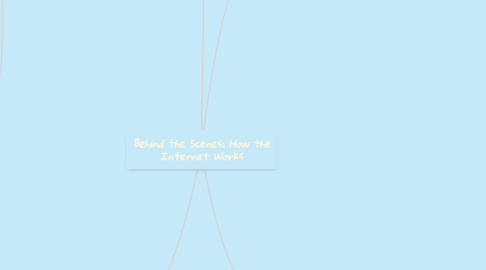
1. Internet Identity
1.1. IP Addresses
1.1.1. The Internet Corporation for Assigned Names and Numbers (ICANN)
1.1.2. The Internet of Things (IoT)
1.2. Domain Names
1.2.1. Organized by level
1.2.1.1. Top-level domain (TLD)
1.2.2. Domain name system (DNS) server functions like an Internet phone book
2. Web Technologies
2.1. Web Development
2.1.1. HTML
2.1.1.1. Informed browser how to display text (size, colors, font etc.)
2.1.2. Cascade style sheet (CSS)
2.1.2.1. Describes how HTML elements should be displayed.
2.1.3. XML (eXtensible Markup Language)
2.1.3.1. Describes what data is rather than how it’s to be displayed.
2.1.4. XML schema diagrams (XSD)
2.1.4.1. Provide method for data validation for a specific XML tag.
2.1.5. JSON (JavaScript Object Notation)
2.1.5.1. Easier-to-use alternative to XML (human readible).
2.2. Application Architecture
2.2.1. Server-side applications
2.2.2. Client-side applications
2.2.2.1. Two main approaches
2.2.2.1.1. JavaScript
2.2.2.1.2. Applet
3. Internet Management and Networking
3.1. MANAGEMENT
3.1.1. Internet Society
3.1.2. Internet Engineering Task Force (IETF)
3.1.3. Internet Architecture Board (IAB)
3.1.4. Internet Corporation for Assigned Names and Numbers (ICANN)
3.1.5. World Wide Web Consortium (W3C)
3.2. NETWORKING
3.2.1. Networking Components
3.2.1.1. Main paths - INTERNET BACKBONE
3.2.1.1.1. a high-speed fiber optic line - OC (Optic Carrier) communication lines
3.2.1.1.2. most of which are owned by commercial (.com), educational (.edu), or government (.gov) organizations (.org)
3.2.2. Data Transmission
3.2.2.1. 2 WAYS
3.2.2.1.1. Circuit switching
3.2.2.1.2. Packet switching
3.2.2.2. 2 PROTOCOL
3.2.2.2.1. the Transmission Control Protocol (TCP)
3.2.2.2.2. the Internet Protocol (IP).
4. Communications Over the Internet.
4.1. Types of Internet Communication
4.1.1. Instant messaging (IM) requires the use of a client program that connects to an IM service
4.1.2. E-mail is one of the most common communication methods on the Internet.
4.1.2.1. to protect your email encryption practices are available :- Two basic types of encryption Private-key encryption Public-key encryption.
4.1.3. Simple Mail Transfer Protocol (SMTP) responsible for sending e-mail along the Internet to its destination.
4.1.4. Multipurpose Internet Mail Extensions (MIME) a specification that enable files to be attached and sent by e-mail

